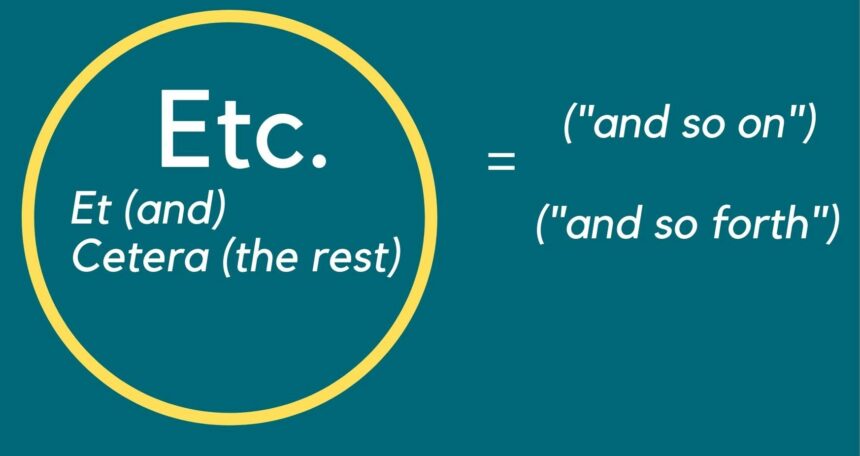You’ve seen it countless times in academic papers, business documents, and casual writing. That little Latin phrase “e cetra” (often abbreviated as “etc.”) seems simple enough, yet many writers struggle with when and how to use it correctly. Understanding this versatile expression can elevate your writing from amateur to polished professional.
Et cetera literally means “and the rest” or “and so forth” in Latin. While it might seem like a minor detail, proper usage of et cetera demonstrates attention to detail and linguistic precision that readers notice. Whether you’re crafting a business proposal, writing an academic essay, or sending a casual email, knowing how to wield this phrase effectively will strengthen your communication skills.
This guide will walk you through everything you need to know about et cetera, from its fascinating origins to modern usage rules that will help you avoid common mistakes.
History and Origins of Et Cetera
The phrase “et cetera” combines two Latin words: “et” (meaning “and”) and “cetera” (meaning “the rest” or “the others”). Ancient Roman writers used this expression to indicate that their lists contained additional items not worth mentioning individually.
During the Medieval period, scribes and scholars adopted et cetera extensively in manuscripts and academic texts. The abbreviation “etc.” emerged as a time-saving device when copying documents by hand. Monks and scholars needed efficient ways to indicate incomplete lists without exhausting precious parchment or ink.
The phrase entered English during the Renaissance, when Latin remained the language of scholarship and formal communication. By the 16th century, English writers were incorporating “et cetera” into their work regularly. William Shakespeare used variations of the phrase in several plays, helping to cement its place in English literature.
As printing became widespread, the abbreviated form “etc.” gained popularity due to space constraints in printed materials. Publishers appreciated the economy of three letters replacing eleven, making et cetera one of the most enduring abbreviations in English.
Modern Usage Rules and Best Practices
Understanding when to use et cetera requires grasping its fundamental purpose: indicating that a list continues beyond the stated items. The phrase works best when readers can easily infer what the unstated items might be.
Use et cetera when listing examples of a broader category. For instance, “The toolkit includes hammers, screwdrivers, wrenches, etc.” works because readers understand that other hand tools belong in this category. However, avoid using it after just one or two items, as this doesn’t establish a clear pattern.
Never combine et cetera with phrases like “and others” or “and so on.” Since et cetera already means “and the rest,” adding these expressions creates redundancy. Similarly, avoid writing “and etc.” because the “et” in et cetera already means “and.”
In formal writing, spell out “et cetera” rather than using the abbreviation. Academic papers, legal documents, and professional reports benefit from the complete phrase. Save “etc.” for informal contexts, lists, and situations where space is limited.
Place et cetera at the end of your list, preceded by a comma. In American English, follow it with a period even if it appears mid-sentence, because “etc.” is an abbreviation. British English sometimes omits this period, but American style guides consistently require it.
Common Mistakes Writers Make
One frequent error involves using et cetera when the list appears complete. Writing “The primary colors are red, blue, yellow, etc.” suggests there are additional primary colors, which contradicts basic color theory. Only use et cetera with genuinely incomplete lists.
Another mistake occurs when writers use et cetera with vague or unclear categories. The phrase “We discussed various topics like politics, weather, etc.” doesn’t help readers understand what other subjects came up. Be specific enough that your audience can reasonably guess the omitted items.
Overusing et cetera weakens your writing. Some authors sprinkle it throughout their text, creating an impression of laziness or imprecision. Instead of relying on et cetera repeatedly, consider whether you need those lists at all, or whether providing complete information would serve your readers better.
Professional writers also struggle with et cetera in series with different grammatical structures. Maintain parallel structure in your lists: “We need to order supplies, schedule meetings, review contracts, etc.” works because all items are actions. Mixing nouns and verbs creates confusion.
e cetra in Different Writing Contexts
Academic writing traditionally favors the complete phrase “e cetra” over the abbreviation. Research papers and scholarly articles benefit from formal tone, making the spelled-out version more appropriate. However, some style guides permit “etc.” in parenthetical citations or footnotes where brevity matters.
Business communication often embraces the abbreviated form for efficiency. Emails, memos, and reports frequently use “etc.” to keep messages concise. Project managers listing deliverables or timeline items find the abbreviation particularly useful.
Creative writing rarely employs et cetera because fiction and poetry typically demand specificity over generalization. When authors do use it, the phrase often appears in dialogue to reflect natural speech patterns or in lists that support world-building without overwhelming readers with details.
Technical writing occupies middle ground, using either form depending on audience and context. User manuals might abbreviate for space, while technical specifications often spell out the complete phrase for clarity.
Alternatives to Et Cetera
Sometimes other expressions serve your purpose better than et cetera. “And so forth” works well in spoken contexts and informal writing. “Among others” suits situations where you want to emphasize that your examples represent just a portion of available options.
For academic writing, consider “and the like” or “and similar items” when you need variety in expression. Legal documents often use “and other” followed by a descriptor, such as “and other contractual obligations.”
In some cases, eliminating the phrase entirely strengthens your writing. Instead of “We sell books, magazines, newspapers, etc.,” try “We sell various print publications.” This approach creates cleaner prose while conveying the same information.
When listing becomes unwieldy, consider reorganizing your content. Rather than providing long lists followed by et cetera, group items into categories or use more descriptive language that captures the breadth of your subject without enumeration.
The Digital Age and Et Cetera
Modern communication platforms have influenced et cetera usage patterns. Social media’s character limits make “etc.” attractive for Twitter posts and Instagram captions. Text messaging has further normalized abbreviated forms across informal digital communication.
Search engines and SEO considerations sometimes discourage et cetera usage because the phrase provides no keyword value. Content creators often replace it with specific terms that improve searchability and provide clearer information to readers.
Email auto-complete features have made typing “etc.” faster than spelling out “et cetera,” potentially shifting usage patterns even in formal digital communication. However, professional email etiquette still generally favors the complete phrase in important business correspondence.
Mastering Et Cetera for Stronger Writing
Et cetera remains a valuable tool when used thoughtfully and sparingly. This small Latin phrase can make your writing more efficient while maintaining clarity for readers. The key lies in understanding its appropriate contexts and avoiding common pitfalls that undermine your credibility.
Remember that et cetera works best when your audience can easily infer the omitted items. Use it to streamline your writing without sacrificing comprehension. Whether you choose the abbreviated or spelled-out form depends on your context, audience, and style requirements.
Practice incorporating et cetera naturally into your writing. Pay attention to how published authors and respected publications use the phrase. With conscious effort, you’ll develop an intuitive sense for when et cetera enhances your communication and when alternative approaches serve you better.


